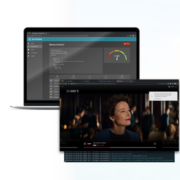Does HD content always mean good quality?

When operators say they deliver good quality, they mostly think about the resolution with which a video is encoded. End users also often only think about “HD” indicators. This is right to some degree. Nevertheless, the quality can depend on many more factors.
Imagine the situation of watching a football championship: It is a nice and sunny day and you plan to watch the video game outside on your mobile phone. Everything runs fine, but suddenly the resolution decreases. Instead of football players, you only see some blurry blocks moving over a green background. That’s annoying! Now, people may react differently to this situation. While some will start to immediately touch the phone, move it around in the hope to get a better signal or reload the service, others might stay relaxed and keep waiting for a better resolution. With adaptive streaming, most video playouts are able to continuously play, even when the network is bad.
But now something really annoying happens. The playout suddenly gets stuck and you see a buffering spinner. As if that were not enough, you suddenly hear cheering sounds from the distance and know, a goal has been scored! And your phone? Still showing a buffering spinner … you missed the goal and everybody else saw it. This is the worst situation that could happen in a live stream playout: Crucial information is missed and the user might abandon the service for repeated failures of this kind.
In the below graphic, you can see how such a streaming session might have played out. The network conditions suddenly change, which means that the video player cannot keep loading the video at the same rate. A well-configured streaming service should still continue playing, but at a lower resolution.

A badly configured service might however stall completely, as shown below. This could also happen with severe network degradations.

Whatever the cause for the underlying network degradations, we see that in the above example, it didn’t matter if the stream was originally delivered in HD. The overall experience was bad, in particular when stalling happened. The delivery of a well-encoded video lacked on the final transport.
Now you could argue that by measuring network statistics, you would have seen that the conditions got worse over time. But from those statistics alone, you wouldn’t be able to tell what actually happened in the video player. You need to measure the entire streaming session, from a user’s perspective.
With our Surfmeter solutions, streaming providers and ISPs can identify such impairments, whether it is an overloaded peering point, a bandwidth limitation in the access network, or a faulty mobile cell, Surfmeter enables providers to monitor the quality from the user’s point of view, by testing the real service under real conditions. With those tools at hand, operators can discover the reasons for failure and optimize the overall delivery chain, so that everyone can see all the football goals in perfect quality.
Interested? Contact us to find out more about how you can use Surfmeter to measure the quality of your service.

